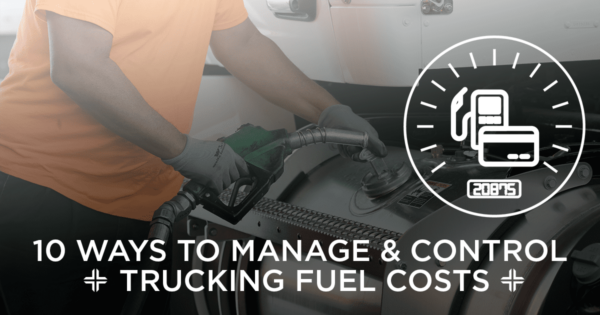Fuel is one of the largest ongoing expenses for any fleet and is estimated to account for 24% of total operational costs. If fuel costs and usage are efficient, it would follow that the fleet itself is running efficiently as well. Unfortunately, managing fuel costs can be extremely challenging in times of inflation, when fuel costs are high. Tracking fuel consumption metrics (MPG, out-of-route miles, idling times) can provide baseline information on how a fleet or driver is performing, but may not take into account all of the variables that impact fuel costs.
Tips to Reduce Fuel Costs for Owner Operators & Fleets
- Reduce average speed & set speed restrictions
Speeding is not only dangerous, it is also the leading cause of increased fuel consumption. According to a study by the University of Michigan Transportation Research Institute (UMTRI), high speeds (over 70 mph) can reduce fuel efficiency by up to 30%. For drivers averaging 130,000 miles a year, this could amount to over $18,000 in additional costs, which is significant for both owner-operators and fleet managers.
Driving slower and setting speed restrictions for drivers can significantly reduce fuel expenses. GPS tracking and telematics help monitor fuel usage, remind drivers when to slow down, and create reports to identify drivers that are not following speed protocols. Combined, this can amount to big saves on fleet fuel costs.
- Avoid aggressive driving
Hard braking and excessive acceleration increase fuel consumption and costs. In addition to wasting fuel, aggressive driving habits cause premature wear on the engine, driveline, and tires, leading to additional costs later. Telematics devices are excellent for monitoring aggressive driver behaviors and provide valuable information for fleets looking to improve both safety and fuel efficiency.
- Reduce unnecessary idling
Many drivers idle to power climate control and accessories in the cab at night. Idling requires about a gallon of fuel per hour. If a driver idles eight hours a day, this costs about $120 per week.
An auxiliary power unit (APU) can provide a solution for fuel lost to idling. APUs cost about $10,000 after installation, but generally pay for themselves in fuel savings after 18 months. Savings are more substantial for cross-country drivers, those typically driving in extreme heat or cold conditions, or those that have pets in the cab, as they are more likely to rely on climate control while idling.
- Regular maintenance
Keeping vehicles properly maintained is another way to maximize fuel efficiency. Proper tire inflation, functional oxygen sensors, and correct alignment all go a long way to reducing fuel consumption and adding profits back to the bottom line.
- Be cautious of specs
Always consider weight and maintenance when selecting or modifying a truck. Heavy engines and fancy chrome wheels look great, but add unnecessary weight, increase fuel costs, and rarely add to a truck’s resale value.
- Upgrades worth considering
While heavy vanity specs may not be wise for fuel economy, there are several options that provide value and reduce fuel costs.
- Roof fairings are incredibly effective at improving aerodynamics and decreasing fuel consumption, increasing MPG by 10 – 14% on average.
- Trailer side skirts are an excellent option due to their affordability (less than $3,000 per trailer) and ability to boost fuel economy by up to 5%.
- Aluminum wheels are often preferred over their steel counterparts as they weigh 30 pounds less, per wheel. They cost more up-front, but provide substantial fuel savings over their lifespan.
- Ship lighter loads
Weight matters. According to the Environmental Protection Agency (EPA) every 100 pounds on a vehicle can reduce fuel economy by up to 1%. While it may not be possible to avoid heavy loads on every trip, owner-operators and fleet managers should be aware of the added costs and negotiate rates accordingly.
- Limit out-of-route miles
Planning trips accurately and cutting out unnecessary miles is critical for managing fuel costs. Using up-to-date GPS systems that alert drivers to traffic or detours, planning fuel stops that fall in-route, and monitoring telemetric data to compare planned miles to actual miles, all help ensure that drivers are following routes and contributing to a more fuel-efficient fleet.
- Convert to electric vehicles
Electric vehicles are designed to be more fuel efficient than gasoline- and – diesel-powered vehicles. They generally cost more upfront than traditional tractors, but have lower maintenance costs and fewer moving parts that break down with repeated use.
- Take advantage of fuel programs
Fuel discount programs and fuel cards are one of the easiest ways to guarantee savings on every trip to the pump. With many options available in recent years, it is important to compare programs before enrolling.
Fuel Programs & Fleet Fuel Cards
Fuel programs and cards have long been used by fleets and owner-operators as a way to secure discounts on fuel, maintenance and repairs. There are many benefits to fuel programs and cards and many considerations to take into account before selecting a program. Below we’ll outline the benefits of fuel cards and things to consider when choosing programs.
Benefits of Fuel Programs & Cards
- Fuel discounts: Without a doubt, saving on fuel is the primary draw for drivers and fleets considering enrollment in a fuel program. Discounts vary widely across programs and are often tied to the size of the fleet, particularly programs that are linked to large nationwide truck stop chains.
- Maintenance and tire discounts: Many programs also offer discounts for tires and maintenance performed in their facilities or within their network. Like fuel, these discounts are varied and should be evaluated closely.
- Improved cash flow: Many fuel programs offer the additional benefit of extending short-term credit to fleets and drivers. This is often beneficial for smaller fleets, as it means cash stays in their account longer, allowing more flexibility in managing expenses.
- Expense tracking: Tracking and monitoring fuel usage is substantially easier with fleet fuel cards than standard credit cards, because they offer a higher level of detail. While a typical credit card transaction lists where a purchase was made and for what amount, fuel cards show additional information – price per gallon, number of gallons, and if anything other than fuel was charged during the transaction. This level of visibility can help managers identify inefficiencies and address issues proactively.
Choosing a Fuel Program: Things to Consider
- Discounts: As mentioned above, discounts on fuel, maintenance, and tires vary widely depending on the program, size of the fleet and payment terms. Small fleets and owner-operators may need to negotiate for better discounts with larger program providers, or specifically look for programs that are designed to support small fleets in order to get the biggest payoff.
- Fees: Fleet fuel cards and programs generally carry a variety of fees for their service. These may include monthly fees or additional fees per card, per transaction, or fees for back office support and reporting. Read details closely and calculate estimated monthly fees before deciding on a program.
- Fuel station coverage: Many fuel programs are linked to specific truck stops and fuel station chains and discounts may only apply to fuel purchased within the network. Consider the density of these stations and how they fit the fleet’s routes. For cross-country drivers, consider a program that has a mix of national and regional chains in order to get the best discounts.
- Fraud protection: As with credit cards, there is a high level of fraud risk associated with fuel cards. When choosing a program, verify what their protections are, what transaction limits exist, and how those are monitored.
- Back Office Support: some fuel programs offer back office support and visibility that extends beyond transaction data. This is particularly valuable for owner-operators and smaller fleets that do not have the same level of office support as large fleets, as it can provide data and reporting that can help them streamline processes and increase efficiencies within their business.
Partnering with Triumph to Manage & Control Fuel Costs
Minimizing fuel costs is essential to building an efficient fleet or independent business, especially when fuel prices are on the rise. For owner-operators and small fleet owners, partnering with a fuel program that understands the unique needs of a small business is the key to managing costs and maximizing profits. Triumph, formerly known as Triumph Business Capital has helped thousands of small fleets and independent drivers manage fuel expenditures with their fuel card discount program. With more than 2,400 nationwide fuel stations, dedicated customer support, and additional maintenance and tire discounts, they provide service and guidance to help small fleets and owner-operators succeed in a competitive market.
Contact the experts at Triumph, formerly known as Triumph Business Capital today to learn more about their fuel programs, factoring services, and more.

